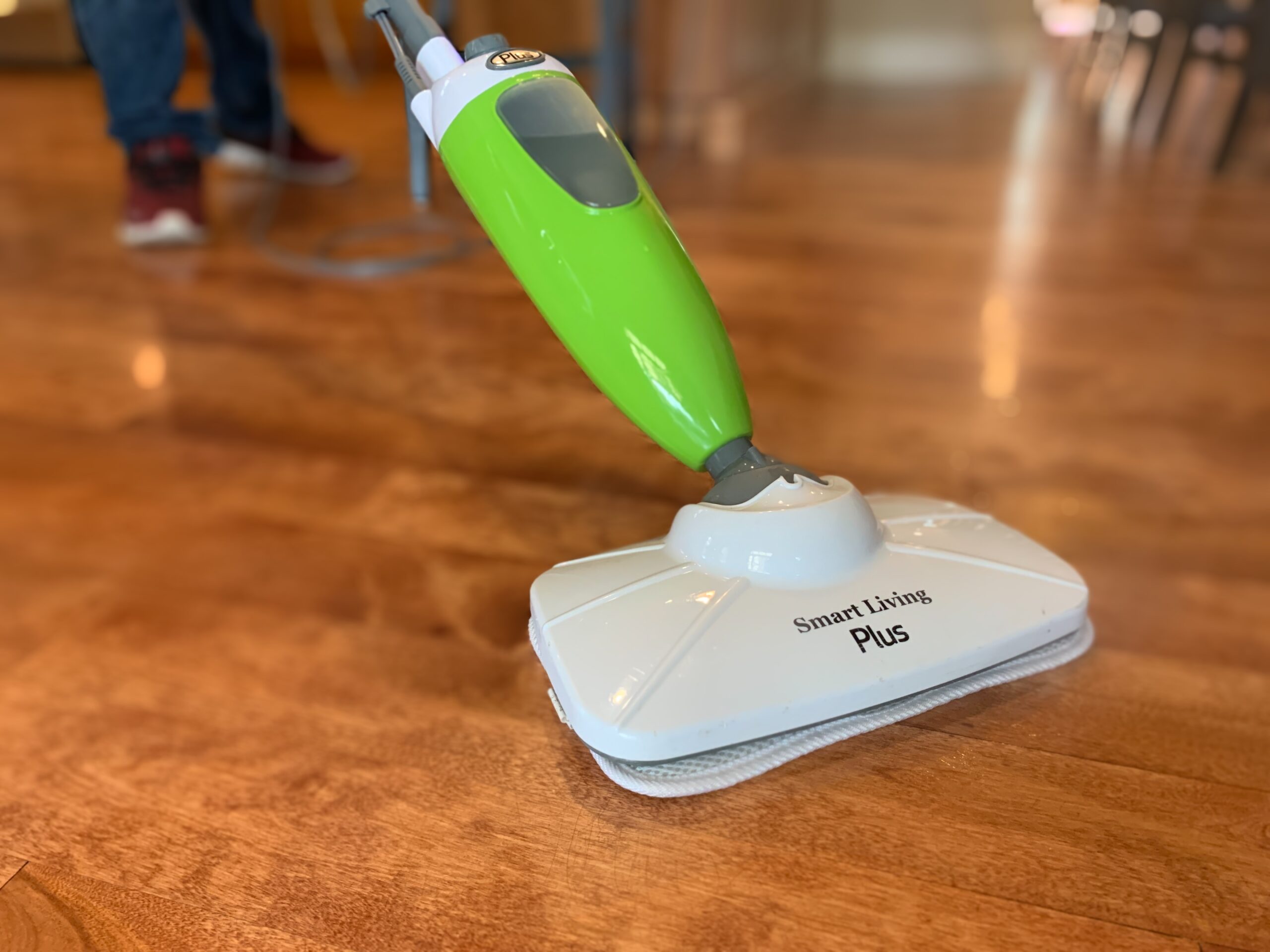
We’ve been told time and again that steam cleaning hardwood floors is not a good thing to do. Others also say that using kitchen staples such as vinegar is a better alternative.
In this post, I’ll share with you the following information about steam cleaning hardwood floors:
Steam Clean Hardwood Floors: Debunking Misconceptions

The answer is a resounding yes. However, we know that such an answer does not put an end to a lot of doubts that people have about steam cleaning hardwood floors.
Many sources say you should not use a steam mop to clean hardwood floors.
Their reasoning, moisture penetration, steam getting into the un-sealed seams of your flooring, or their concern of residual moisture left behind after steam cleaning hardwood floors.
So, to address that point, definitely do NOT use a steam mop to steam clean unsealed floors, you will for SURE RUIN them.
Now for the caveat, even though there are several sources that will discourage you from steam mopping your hardwood floors, where I see a disconnect is with their suggested way of cleaning natural hardwood floors.
The suggested way is to mop your floors with vinegar and warm water, or, another way is to use vinegar, warm water and a few drops of castile soap.
From my perspective, these methods could be potentially more hazardous to your hardwood floors than steam cleaning.
Not only putting water on and around your hardwood floors, but you’re putting WAY more water on your floor than you would be if you used a steam mop, which really doesn’t make a whole lot of sense to me.
Speaking from personal experience and in my opinion, we have had GREAT success steam cleaning our hardwood floors without any issues of causing damage.
When we steam clean hardwood floors there is a very little amount of moisture left behind, and what moisture is left dissipates, by far, much quicker than any amount of warm water and a mop bucket would.
Steam Clean Hardwood Floors: Know What Type of Hardwood Floor You Have

This brings us back to the question – “Is it okay to steam clean hardwood floors?” To answer this query, first you have to identify what type of hardwood floor you have.
Hardwood floors also have varying types of finish. For example, some hardwood floors have water-based polyurethane, acid-cured or moisture-cured urethane.
Others have aluminum oxide finish. All kinds of hardwood flooring that have these types of finish can all be steam cleaned.
Hardwood flooring comes in different types. These include wood grain vinyl flooring, laminated hardwood, sealed and unsealed hardwood.
Except for unsealed hardwood, other types of hardwood floors can definitely be steam cleaned without the risk of damaging them.
How to Steam Clean Hardwood Floors
1. Check whether your hardwood floor is sealed or unsealed.
In order to check whether your hardwood floors are sealed, try dropping a little amount of water onto the hardwood flooring. Do this in an inconspicuous part of your floor.
If the drop of water on the following beads up, then this would mean you have a sealed hardwood floor.
But if you see the water disappearing as it absorbs into the wood, then what you’ve got is an unsealed hardwood floor.
2. Check for loose boards or gaps.
I also find it necessary to always check for any presence of loose boards or any gaps in between boards.
The number one reason why people think it is not safe to steam clean hardwood floors is the possibility of having too much moisture buildup.
This is possible if hardwood floors have gaps and loose boards in between where water can get in.
Avoid running your steamer on worn spots otherwise moisture may seep down in and damage your floor.
3. Spot check your hardwood floor.
Some steamers do operate on water alone, but if yours needs a cleaning solution, remember to do a spot check in an inconspicuous part of your floor.
Put a tiny drop of the chemical solution that you will be using and see if this results in any adverse reaction to the quality of your hardwood flooring.
4. Prepare your hardwood floor for steam cleaning.
The next important step is to sweep or, my personal preference, vacuum your floors before you begin to steam clean.
Now, I certainly have vacuumed the day prior and thought, well it’s ok, I just vacuumed yesterday, no need to do so again, if your house is like mine and you have a fur baby, it would likely serve you best to go ahead and vacuum again.
Be sure to get into the corners and along baseboards, sometimes little granules of dirt collect there, even when you’re a no-shoe house like ours, but you have a fur baby or two, they don’t seem to take their shoes off when coming into the house… Silly pups.
Any dust and dirt particles must be removed as these may cause scratches on the surface of the floor.
5. Prepare your steam cleaner.
Check the water level in your steam mop cleaner to make sure you have a full tank to begin with, followed by checking that you have a clean steam mop pad attached and ready to clean.
Now you’re ready to steam clean hardwood floors. Turn your steam cleaner on and give it a moment to warm up, make sure you’re seeing steam before beginning to clean.
You can try to start mopping before the steam has made its way through the steam pad, but it’s really not cleaning anything yet, so give it a sec.
Begin by steam mopping one corner and make sure to steam clean thoroughly so that no areas are left uncleaned.
Steam Cleaning Hardwood Floors: 4 Benefits of Steam Cleaning

One of the big advantages of using a steam mop cleaner to clean your floors is that steam serves two purposes.
Steam both cleans and disinfects all without harsh chemical cleaners. Steam cleaners heat the water to 212º F / 100ºC, killing the germs and bacteria on your floor.
Germs and bacteria thrive at temps of 40º – 140º F (4º-60ºC) and on the flip side germs and bacteria die at temps above/over 140º F. So you can rest assured your floors are getting clean and disinfected as well.
This is good news knowing the fact that floor materials also serve as reservoirs of microbes. So, steam cleaning your hardwood floors definitely makes indoor pollution one less thing to worry about.
Steam cleaning does a great job of cutting down your floor cleaning time by about half. In other words it would take you twice as long to clean your floors using a regular floor mop.
Not to mention, your floors dry super quick when you steam clean them simply because there’s not very much water residue left behind.
It’s important to note however to avoid leaving the steam mop unattended. If you’re distracted or need to step away from cleaning the floors, it’s important to turn the steam function off so you avoid the steamer sitting idle and continuing to steam your floor.
Ideally you should move the steamer up off the floor so it’s not sitting idle in one place.
The best part about your floor steam mop is you no longer have excess water used, filling buckets of water, dirtying the water, changing and cleaning again.
This exhausting process is entirely eliminated, now all you have to do is swap out the steam mop pad for a fresh, clean one.
There are quite a few different steam mop brands on the market to choose from. Bissell makes them, Smart Living, so does Shark, there’s also PurSteam ThermaPro, Dupray Neat Steam and many more.
To see a list of all these check out this article by Real Simple.
Steam mop cleaners are thought of as the “green” form of cleaning since chemicals are not needed to achieve a clean surface. Steam cleaning naturally sanitizes and kills germs, so there’s no need to add chemicals in your cleaner.
Additionally, if you did decide to use chemicals in your steam mop water mixture, it could void your manufacturer warranty.
Not to mention the fact that vaporizing chemicals that aren’t designed to be vaporized could be harmful to your health, so again just don’t do it and stick with steam cleaning using the magical powers of water.
In conclusion, steam cleaning hardwood floors is absolutely possible, just make sure you’re steam cleaning a sealed hardwood floor. Follow the steps mentioned above and rest assured that you’ll have steam cleaned hardwood floors.
If you like this blog post be sure to enter your email into our newsletter so you can be notified when we post new articles.

